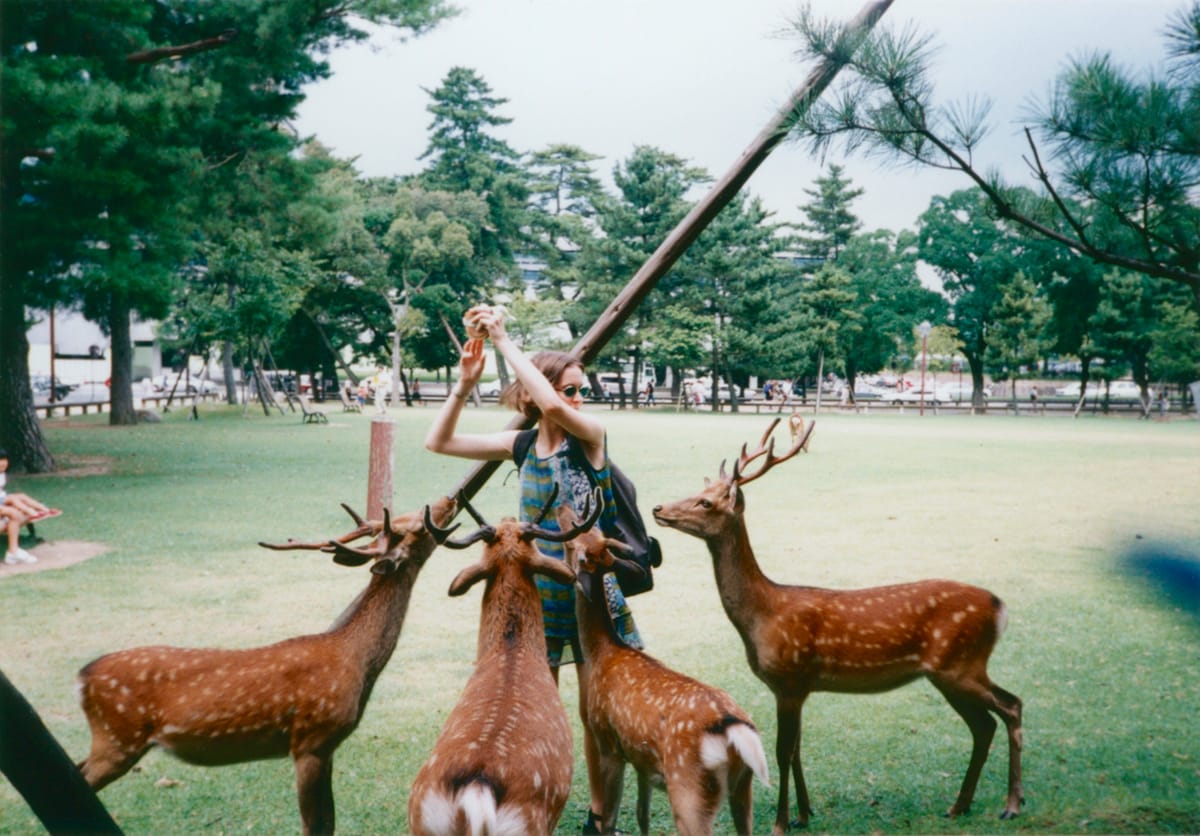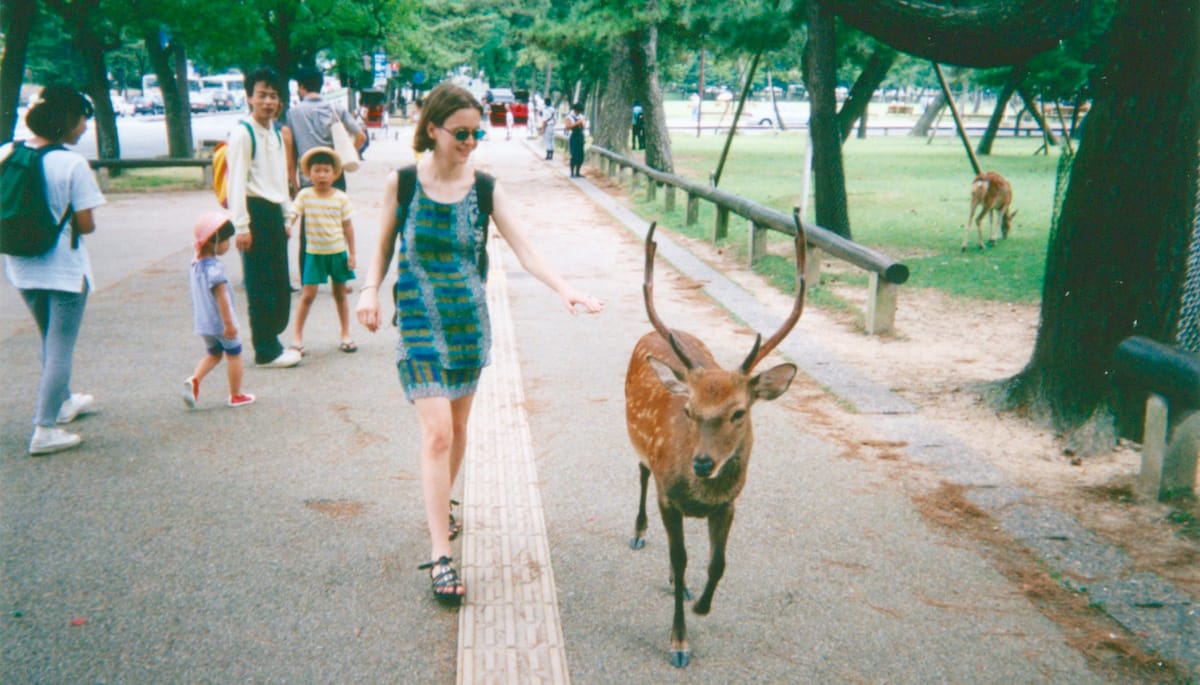Somehow, I’d missed the part about the deer.
I’d read everything in the guidebook about Nara, or at least I thought I had. I’d read that Nara’s temple, Todai-ji, sheltered a gargantuan bronze statue of the Buddha, the largest of its kind in the world, and that, on the outskirts of the city, there was a pleasant hiking trail, which meandered past tea fields and a scattering of Buddhist sculptures.
One sweltering summer day, I was on holiday from my job teaching English in Osaka, so a friend and I took the train to Nara. Minutes after we arrived, we were on a busy street when we saw not one but several deer. And they did not have the classic deer-in-headlights look. They were not afraid.
I was astounded; I had never before seen deer in the bustling heart of a city. As I pointed and squealed, various Japanese people flashed me with bemused smiles. Clearly, they were not surprised that there were deer prancing on Nara’s sidewalks.
Deer, I was to learn, have a long history in Nara. According to legend, Shinto god Takemikazuchi-no-mikoto rode into the city on the back of a white deer. In 768 C.E., the shrine Kasuga-taisha was established in Nara to honor Takemikazuchi-no-mikoto as well as several other Shinto gods, and ever since that time the gods have been sending messengers in the form of deer to protect the city. While it was a crime punishable by death to kill one of Nara’s sacred deer until the seventeenth century, they lost their sacred status after World War II and were designated as National Treasures.
Deer are not one thing, not easy to pin down. They are complex, dynamic.
The fact that I missed any mention of deer while planning my trip to Nara seems to me now as indicative of how I thought about deer in general. That is, I virtually never thought about them. Not being shellfish or dogs or cockroaches, deer were not animals that I ate or loved or despised. I knew they were associated with the hunt—the gentle, noble, wild victims of it—and I didn’t feel a connection to that image. If deer were anything at all to me, they were simply the fleeting view of their hindquarters disappearing into some thicket. And that was rare; I was, and still am, a city-dweller.
But in Nara, coming face to face with so many dappled, perky-tailed deer, I felt forced to consider them, both as spiritual symbols and as living, breathing creatures. In either case, I discovered, deer are not one thing, not easy to pin down. They are complex, dynamic.
Deer are native to every continent except Australia and Antarctica and live everywhere from prairies to mountains, from tundra to tropical rainforests. Molting twice a year, they wear thin summer coats and thick winter ones, and these coats range from foxy red to chocolate brown and sometimes even lean toward grey. The world’s most diminutive deer is the northern pudu, which when fully grown can weigh as little as 7.3 pounds. On the other end of the cervid spectrum is the moose, standing at 8.5 feet and weighing up to a whopping 1,800 pounds.
Deer are ruminants, cud-chewers with four-chambered stomachs, but some will consume meat if it’s available. With long, powerful legs, deer are excellent swimmers, jumpers, sprinters. They have large ears, always cocked to danger, and with the exception of Chinese water deer, all male deer sport antlers, be they simple spikes or ornate branches.
In art, deer first reared their antlered heads in Paleolithic cave paintings. Later, they lent their noble spirit to heraldry and leapt into literature. “A wounded deer leaps the highest,” wrote Emily Dickinson. “Three times it cried out/but now not heard anymore,/a deer in the rain,” wrote Buson. And, of course, there was Bambi.
In Old and Middle English, the word “deer” (that is, dēor and der respectively) simply meant animal, suggesting that the deer was an animal of particularly meaty importance. In other words, while I enjoy going to the supermarket and purchasing avocadoes and tins of tuna, my ancestors did not have that luxury. By necessity, the deer as a symbol of the hunt was, for them, deeply evocative.
Deer hold a place in mythological and spiritual traditions from around the world. But being a Buddhist I’m particularly fascinated by their role in Buddhism.
First and foremost, in Buddhism, deer symbolize the Buddha’s most essential teachings and the act of receiving them. After all, it was in the Deer Park that the Buddha taught for the very first time. When we see a doe and buck flanking a dharma wheel, we are reminded that the Buddha taught in order to save all beings, not just humans.
Deer are also well represented in the Jataka Tales, which are fantastical parables attributed to the Buddha and which deal with his previous incarnations—human and animal. We don’t need to believe that these tales are historically accurate in order to understand their message of wisdom and compassion.
The Deer Listened
After awakening, the Buddha hesitated. Should he teach, or shouldn’t he? Would anyone else ever be able to understand the truth that he’d discovered? Yes, he finally decided, some—very few—would listen. And some—even fewer—would awaken. He needed to teach for them.
The Buddha made his way to the Deer Park at Sarnath, a place close to Varanasi that deer frequented, in order to find his five former companions. For six years, the Buddha had practiced austerities with them on the banks of a river. In hope of gaining enlightenment, he had meditated incessantly, starved himself until he was skin and bone, and limited his breathing until his head had felt like it would split open. Eventually, however, he’d realized that self-deprivation would never lead to awakening, only death. His abandoning asceticism had been a great disappointment to his five companions and so they tried to ignore him when he arrived at the Deer Park.
But they couldn’t. They couldn’t ignore him because he was visibly changed. In his bearing, there was an uncanny peacefulness, an extraordinary dignity. The five ascetics sat before the Buddha and received his teachings. Deer were present and, it is said, they too listened.
Deer know suffering intimately. Perhaps it was that knowledge that drew them to listen when the Buddha taught. I like to picture their large, velvety ears wholly cupped to him.
The first noble truth that the Buddha taught is that there is suffering. Our suffering is like an illness and if we are ever to cure it, we first need to acknowledge it. Often, our suffering is subtle—more like vague dissatisfaction. Sometimes, it is extreme.
The second noble truth is that we suffer because of our craving and fundamental ignorance. We cling to our misguided belief that we are a separate, independent self and—struggling against the natural challenges in life—we strive to get something better for “me.” This struggle is painful and futile. Our ego can never get enough.
The third noble truth is simply that a way out of suffering exists, and the fourth is that the way out is via the eightfold path: wise understanding, wise intention, wise speech, wise action, wise livelihood, wise effort, wise concentration, and wise mindfulness. In short, the Buddha taught that if we live ethically, meditate, and cultivate wisdom, we have the potential to discover freedom from suffering, just as he did.
It strikes me as richly symbolic that deer—so often hunted and sacrificed—were present when the Buddha proclaimed that he taught suffering and the end of suffering. Buddhism teaches that when we experience pain it is like being shot by an arrow. If we don’t resist the pain, all we feel is that one arrow, but when we do resist it, it’s as if we have shot ourselves with a second arrow. That second arrow is our suffering. Arrows, here, are a metaphor, yet for deer arrows can be very literal. Deer know suffering intimately and so perhaps it was that knowledge that drew them to listen when the Buddha taught. I like to picture their large, velvety ears wholly cupped to him and the first turning of the wheel.
Who Is the Deer?
Of all the Jataka Tales, this is one of the most widely known and most poignant:
Nigrodha was a bright-eyed stag with silvery horns and a golden hide. He led a herd of five hundred deer, while Sakha, another handsome stag, was the leader of a similarly large herd. To satisfy one king’s hunger for meat, both herds were driven into a stockade.
Every day, the king’s hunters went to the stockade for the purpose of shooting and killing one deer for the king’s table. Nigrodha and Sakha were such magnificent beasts that the king granted them immunity from this fate, but all the other deer suffered terribly. Every day, as the arrows rained down, there was terror and chaos. Many deer were injured and sometimes there was more than just the one required death.
Nigrodha proposed a system to prevent unnecessary suffering. The deer that was to die would be selected by lottery. One day, the deer would hail from Nigrodha’s herd, then the next day from Sakha’s. The selected deer would go without struggle to his or her death in order to keep the others safe. The deer followed this system until one day a pregnant doe from Sakha’s herd found herself chosen to die.

The doe went to Sakha and begged him to spare her life until her fawn was born and old enough to fend for himself. Sakha, however, was hard with her and said that there was no room for mercy in this system.
In desperation, the doe went to Nigrodha and implored him to intervene. “It is unfair that two should die instead of one,” he agreed. “You are safe until your fawn is born and thriving.”
When the time came for the slaughter, Nigrodha offered himself in the doe’s place. The king—in awe that Nigrodha would make this sacrifice for a deer who wasn’t even in his herd—immediately proclaimed that he would spare the life of Nigrodha as well as the doe.
“No,” said Nigrodha, “I won’t be spared if that will put another deer in jeopardy of being selected for slaughter.”
Again, the king was awed and humbled by Nigrodha’s depth of compassion and, with that, he promised to forever forgo hunting deer, whether inside the stockade or in the wild.
“No,” said Nigrodha, “we won’t be spared if that means that you will hunt other animals all the more.”
And with that the king promised to forever forgo hunting any type of beast, and from that day forward the entire kingdom was a place of refuge for every creature great and small.
Tradition tells us that when the Buddha concluded this tale, he claimed that in a previous life he was Nigrodha, while his brother-in-law Devadatta was Sakha and his cousin Ananda was the king, and his student Kumara-Kassapa was the doe’s offspring.
Who are all of these people? For me, that’s not the important question. What’s important is who am I; who are you?
Here is what I think of as something of a Jataka Tale from my own life:
My father was a hunter in a long line of hunters.
He and my mother were divorced, and I lived with her. I only visited my father in the summers, outside of hunting season. So, though I was familiar with his rifles and the bony boar jaw he kept on his desk, I never saw fresh kill. Except once.
One summer when I arrived, there was a deer dangling from the garage ceiling. Hanging by its legs, the doe’s position felt jarringly wrong; her stillness was eerie. I couldn’t bring myself to touch the soft hide; I could barely bring myself to look at her.
So that’s the end of my Jataka Tale. Now, who is the deer in this story? Who is the hunter? And who is the girl?
The answer, I have reluctantly come to admit, is that they are all me. I am the hurting deer, subject inevitably to that eerie stillness, and I am the human hunter, hurting others in my ego-fueled ignorance. And, also, I am the girl. The girl who doesn’t “feel a connection to the hunt.” The girl who would rather look away.
Now, who are you in the story?
And when will you and I be ready to listen—really listen—to the Buddha’s teachings?

